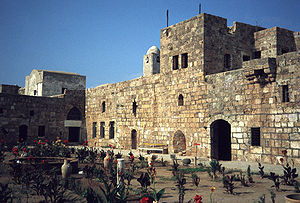Siege of Aruad

The island fortress of Aruad served the crusaders as a bridgehead for a joint offensive with the Mongols.
| date | 1302 |
|---|---|
| place | Aruad |
| output | Victory of the Mamelukes |
| Parties to the conflict | |
|---|---|
|
|
|
| Commander | |
|
Sayf Dīn Zarrāk al-Manṣūrī |
|
| Troop strength | |
| 120 knights 500 archers 400 civilians |
unknown 16 ships |
| losses | |
|
all |
unknown |
The siege of Aruad took place in 1302 on the island of Aruad on the coast of Syria . With the island fortress on September 28, 1302, the last outpost of the crusaders on the Levant coast finally fell into the hands of the Muslim Mamelukes .
prehistory
Over the previous 200 years, the Crusader states had gradually been pushed back by the Muslims. After the fall of Jerusalem , the Crusaders moved their headquarters to the coastal city of Acre in 1191 , where they stayed for 100 years until the fall of the city on May 28, 1291. The headquarters were first moved to Tartus , to the north , but the city fell in the the same year to the Mamelukes , whereupon the crusaders gave up their positions on the mainland (especially Château Pèlerin ) and withdrew their headquarters to the island of Cyprus . The last king of Jerusalem , Heinrich von Lusignan , who was also king of Cyprus, tried in 1300 together with the three most important knights of knights ( Templars , Hospitallers and Teutonic Knights ) to recapture Tartus in order to gain a foothold on the mainland. Immediately across the coast from Tartus was the tiny fortified island of Aruad . The troops first embarked for Aruad in order to attack the city from the sea, while at the same time the allied Mongols under Ghazan Ilchan were to attack from the land side. Since the Mongols were months late, most of the troops returned to Cyprus without having achieved anything.
siege
The Templars tried to establish a permanent base on Aruad. The possession of the island was confirmed to them by Pope Boniface VIII . Their garrison consisted of 120 knights, 500 archers and 400 men and women as civil servants (mostly Syrian Christians). The command of the base was Barthélemy de Quincy , Marshal of the Templar Order.
In 1302 the Mamelukes sent a fleet of 16 ships from Egypt to Tripoli , from where they began the siege of the island. They landed in two places and set up a fortified camp. The Templars defended themselves bitterly, but after initial successes were eventually pushed back into the central donjon of the island fortress and finally starved there. Brother Hugues de Dampierre agreed with the besiegers to surrender the island on September 26, 1302, on condition that they were given safe conduct to a Christian country of their choice. When the defenders opened the gates on September 26, the Mamelukes broke the agreement and attacked the Christians. Barthélemy de Quincy was killed in the following skirmish, all archers were executed, some of the civilians were taken into slavery, and dozens of the surviving Knights Templar were incarcerated as prisoners in Cairo . According to the report of a fellow prisoner in Cairo at the time, the Genoese Matthias Zaccaria , 40 of them were still alive years later, who were ultimately starved to death after stubbornly refusing to convert to Islam.
A Cypriot fleet for the relief of the island had already left Famagusta , but did not arrive in time.
consequences
Aruad was the last Latin Christian settlement in the Holy Land . In 1303 the Mongols again advanced into Syria with a huge army, together with their Christian allies from Lesser Armenia , but could not gain any decisive territorial gains. Finally, the Mongols and their Armenian vassals were defeated in the Battle of Homs on March 30, 1303 and the decisive Battle of Shaqhab, south of Damascus , on April 21, 1303.
After the fall of Aruad, the crusaders from Cyprus carried out a few more raids on the Syrian coast and destroyed the city of Damur, south of Beirut . However, they could never again establish a permanent base on the Levant coast.
literature
- Alain Demurger: Jacques de Molay. Payot, 2007 ( ISBN 2-228-90235-7 ).
- Malcolm Barber: The Trial of the Templars. Cambridge University Press, 1978 ( ISBN 0-521-45727-0 ).
- Malcolm Barber: The New Knighthood. A History Of The Order Of The Temple. Cambridge University Press, 1995 ( ISBN 0-521-55872-7 ).
- Peter Jackson: Mongols and the West: 1221-1410. Longman, 2005 ( ISBN 0-582-36896-0 ).
- Urbain Vermeulen, D. De Smet, J. van Steenbergen (Eds.): Egypt and Syria in the Fatimid, Ayyubid and Mamluk Eras. Peeters Publishers, 2001, ISBN 9-042-90970-6 .
Individual evidence
- ↑ Malcolm Barber, The Trial of the Templars , p. 22
Coordinates: 34 ° 51 ′ 21 ″ N , 35 ° 51 ′ 32 ″ E